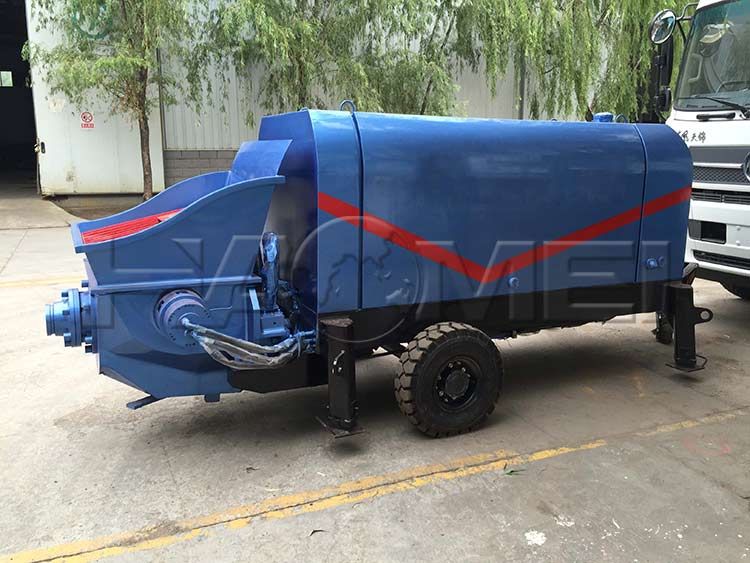Will You Choose Concrete Pump Tow Behind
Posted On: 30/09/2025 | Posted by: Haomei Concrete Pumps
In the construction industry, concrete pouring is a core process, and the choice of equipment directly impacts project progress, quality, and cost. After comparing various equipment options, many construction teams ultimately choose a concrete pump tow behind. What makes it so preferred?

1. Efficient pouring
The bottleneck in concrete pouring often lies in the "transportation" stage. Traditional concrete trucks, which unload directly, are only suitable for pouring on flat ground and at short distances. However, when faced with situations requiring crossing obstacles, pouring at high-rise buildings, or long-distance transport, unloading becomes difficult and spreading becomes slow. The concrete pump trailer overcomes these limitations:
It is equipped with high-strength conveying pipes that can be flexibly spliced according to construction needs. Its horizontal conveying distance can reach 100-300 meters, and its vertical conveying height can reach buildings over 10 stories. Even within construction sites with obstacles such as walls, foundation pits, and equipment stacks, the pipes can precisely deliver concrete to the pouring site.
Crucially, trailer-mounted concrete pumps offer a stable delivery rate. Conventional models can deliver 30-80 cubic meters of concrete per hour. Furthermore, they minimize concrete slump loss during pouring, reducing construction joints caused by untimely delivery. This not only ensures pouring quality but also compresses a pouring task that originally took 2-3 days to just one day, significantly shortening the project timeline.
2. Controllable costs
For construction teams, "reducing costs and increasing efficiency" is a constant pursuit. The cost-effectiveness of trailer-mounted concrete pumps makes them an ideal choice for small and medium-sized projects:
In terms of equipment investment, the purchase cost of a trailer-mounted concrete pump is significantly lower than that of a concrete pump truck (boom pump), and there are no costs associated with boom maintenance or the high maintenance of the hydraulic system. For teams with an annual construction volume of less than 10,000 cubic meters, the cost of a trailer-mounted pump can be recovered within one or two projects. If renting a trailer-mounted pump, the daily rental cost is only 1/3 to 1/2 that of a truck-mounted pump, significantly reducing the initial financial burden.
In terms of labor and auxiliary costs, trailer-mounted concrete pumps are simple to operate. A single operator can complete equipment commissioning and operation, eliminating the need for additional boom operators. Furthermore, trailer-mounted concrete pumps have low construction site requirements, eliminating the need for reserved space for large equipment and clearing obstacles for the boom truck deployment, indirectly reducing the labor and time costs associated with site preparation.
3. Flexible adaptability
Construction scenarios are complex and diverse, ranging from confined indoor reinforcement to expansive outdoor pouring, and from standard C30 concrete to high-grade, large-aggregate concrete. These requirements place extremely high demands on equipment adaptability. The flexibility of a trailer-mounted concrete pump precisely meets these diverse needs:
In terms of site adaptability, trailer-mounted pumps are compact (typical models are approximately 5 meters long and 2 meters wide), allowing them to fit through narrow construction corridors into indoor spaces, basements, and urban village construction sites. They can even be disassembled and transported via elevator to high-rise floors for pouring, a feat impossible with bulky truck-mounted pumps.
In terms of concrete compatibility, high-quality trailer-mounted pumps are equipped with large-diameter delivery cylinders and wear-resistant pipes, capable of transporting concrete with aggregate sizes up to 80 mm. Whether it's standard commercial concrete, self-mixed concrete, or special concrete with admixtures, they deliver stable delivery with minimal pipe blockage.
Furthermore, trailer-mounted pumps can be used with concrete placing booms, whose 360-degree rotation enables uniform distribution over a wide area, further enhancing pouring flexibility.
4. Easy maintenance + high durability
The reliability of construction equipment directly impacts project progress. Equipment failure can cause concrete to set, delay construction, and result in significant losses. The portable concrete line pump, on the other hand, feature a relatively simple structure. Core components (such as the delivery cylinder, hydraulic pump, and motor) utilize proven technology, resulting in a low failure rate and easy maintenance.
For routine maintenance, operators only need to check the hydraulic oil level, clean the filter, and lubricate key components as required, eliminating the need for complex specialized procedures. In the event of minor malfunctions, replacement parts are readily available and affordable, allowing ordinary maintenance personnel to complete the replacement. This eliminates the need for specialized manufacturers and the long wait times associated with pump truck repairs.
In terms of durability, high-quality trailer pumps feature pipes made of high-chromium alloy, which is highly wear-resistant and has a service life of 10,000-20,000 cubic meters. The hydraulic system utilizes closed-loop control, reducing pressure loss and extending the life of hydraulic components. Many construction teams report that a properly maintained trailer pump can provide stable service for 5-8 years, providing reliable support for long-term construction.
Original source: https://www.concrete-pump-cn.com/a/will-you-choose-concrete-pump-tow-behind.html
Tags: concrete pump trailer,
Previous: Trailer Concrete Mixer Pump In Lithuania
Next: What Are Types of The Concrete Lifting Pump


 feedom@haomei-machinery.com
feedom@haomei-machinery.com